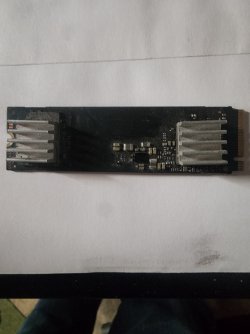Exodus6124
New Member
- Joined
- Oct 31, 2022
- Messages
- 6 (0.01/day)
Hello, I own a 12th gen Dell Precision laptop. I recently upgraded its storage with a 2 TB WD Blue SN580. I specifically picked this model despite it lacking a DRAM chip, as I was worried about overheating. According to its datasheet, this model barely passes the 5W mark at maximum load (and it was also among the cheapest in my country in terms of capacity/cost).
My laptop has two NVMe slots: one is close to the GPU (which comes with a copper heat sink provided by Dell in the slot) and the other has no mounting screws for a heat sink and is located right next to the fan exhaust. I chose to plug it into the one closer to the fan exhaust, as Dell manual specified that it gets less heat. Everything is fine when the fan is working, but for instance, right now I am simply browsing the web, so the CPU is below 50 degrees and the fan never spins up. Despite not doing anything involving IO, what I assume to be the NVMe controller board gets extremely hot, even at a low-power state. According to the other sensors in my laptop, none of the other components are above 50 degrees, so this is most certainly its own heat. I don't understand; I thought these NVMe drives did not need active cooling.
I don't know if it would be any different with Windows, as I don't have it installed, but I imagine it would be the same case without the fan spinning. Any suggestions? For reference, I'm attaching a photo of the laptop's internals that I found online.
NVME temperature when fan is running at 1-2k RPM:
My laptop has two NVMe slots: one is close to the GPU (which comes with a copper heat sink provided by Dell in the slot) and the other has no mounting screws for a heat sink and is located right next to the fan exhaust. I chose to plug it into the one closer to the fan exhaust, as Dell manual specified that it gets less heat. Everything is fine when the fan is working, but for instance, right now I am simply browsing the web, so the CPU is below 50 degrees and the fan never spins up. Despite not doing anything involving IO, what I assume to be the NVMe controller board gets extremely hot, even at a low-power state. According to the other sensors in my laptop, none of the other components are above 50 degrees, so this is most certainly its own heat. I don't understand; I thought these NVMe drives did not need active cooling.
I don't know if it would be any different with Windows, as I don't have it installed, but I imagine it would be the same case without the fan spinning. Any suggestions? For reference, I'm attaching a photo of the laptop's internals that I found online.
Code:
$ sensors nvme-pci-0300
nvme-pci-0300
Adapter: PCI adapter
Composite: +67.8°C (low = -40.1°C, high = +83.8°C)
(crit = +87.8°C)
Sensor 1: +84.8°C (low = -273.1°C, high = +65261.8°C)
Sensor 2: +67.8°C (low = -273.1°C, high = +65261.8°C)
# nvme smart-log /dev/nvme0
Temperature Sensor 1 : 85 °C (358 K)
Temperature Sensor 2 : 67 °C (340 K)
# nvme get-feature /dev/nvme0 -f 0x0c -H
get-feature:0x0c (Autonomous Power State Transition), Current value:0x00000001
Autonomous Power State Transition Enable (APSTE): Enabled
# nvme id-ctrl /dev/nvme0
ps 0 : mp:4.80W operational enlat:0 exlat:0 rrt:0 rrl:0
rwt:0 rwl:0 idle_power:0.3000W active_power:4.80W
active_power_workload:80K 128KiB SW
ps 1 : mp:3.50W operational enlat:0 exlat:0 rrt:0 rrl:0
rwt:0 rwl:0 idle_power:0.3000W active_power:3.00W
active_power_workload:80K 128KiB SW
ps 2 : mp:2.40W operational enlat:0 exlat:0 rrt:0 rrl:0
rwt:0 rwl:0 idle_power:0.3000W active_power:2.00W
active_power_workload:80K 128KiB SW
ps 3 : mp:0.0150W non-operational enlat:1500 exlat:2500 rrt:3 rrl:3
rwt:3 rwl:3 idle_power:0.0150W active_power:-
active_power_workload:-
ps 4 : mp:0.0050W non-operational enlat:10000 exlat:6000 rrt:4 rrl:4
rwt:4 rwl:4 idle_power:0.0050W active_power:-
active_power_workload:-
ps 5 : mp:0.0033W non-operational enlat:176000 exlat:25000 rrt:5 rrl:5
rwt:5 rwl:5 idle_power:0.0033W active_power:-
active_power_workload:-
# nvme get-feature /dev/nvme0 -f 2 -H
get-feature:0x02 (Power Management), Current value:0x00000004
Workload Hint (WH): 0 - No Workload
Power State (PS): 4NVME temperature when fan is running at 1-2k RPM:
Code:
$ sensors nvme-pci-0300
nvme-pci-0300
Adapter: PCI adapter
Composite: +39.9°C (low = -40.1°C, high = +83.8°C)
(crit = +87.8°C)
Sensor 1: +50.9°C (low = -273.1°C, high = +65261.8°C)
Sensor 2: +39.9°C (low = -273.1°C, high = +65261.8°C)





